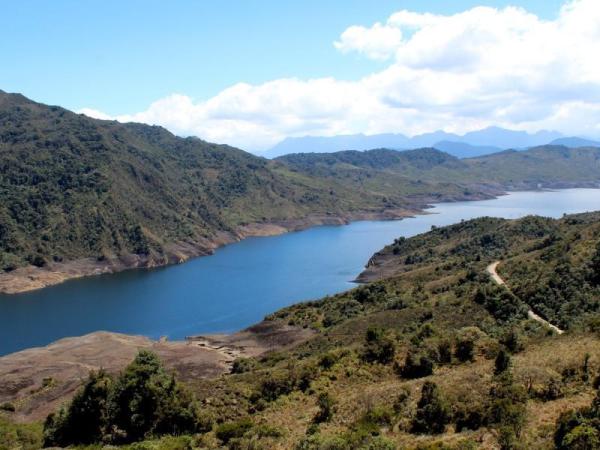Bogotá already complies Three months of restrictions on water supplyafter the difficulties caused by the severe drought at the beginning of the year. Natasha Avendaño, manager of the Bogota Water and Sewer Company, explained that It is expected that by October there will be a level of 70% in the city’s reservoir system, so that we can cope with the dry months at the beginning of the year.
(Read: Until when will Bogotá have water with the current storage capacity)
He also said that they are working on Supply options so that the city has water after 2033since there is expected to be a shortage by then. Buying Tominé or building a new reservoir are among the options.
What is the outcome of the planned power cuts in Bogotá?
We have to recognize the people of Bogota who have fulfilled the task of being more responsible with water consumption and that was the objective for moving to a new restriction scheme. On average, we have reduced consumption by 1 cubic meter per second on days when we have not had restrictions, which implies only voluntary consumption.
This also brings a responsibility as users to not let their guard down and maintain behavioral changes.
(We suggest: With the new model, how long would water rationing last in Bogotá?)
The goal was for consumption to be around 16.6 cubic meters per second in this new phase and we are around 16.5 cubic meters in the days we have been measuring.
How has the recovery of the reservoirs progressed?
We have returned to the upward trend in recent days, since the end of June was dry, without much influx for the Chingaza system. We have had a more or less constant level of rainfall in recent days, although below the historical average, but which has allowed us to return to an upward trend.
Historically, July, August and September are the rainiest months for the system and since we know that we are in an atypical weather situation, we hope that the rains will recover.
(Of interest: Snow shortage in the Himalayas threatens water supply to a quarter of the world)
The recovery level in the reservoir is 20.5% thanks to the reduction in consumption by users in the three months of application of the measure. This means that if we return to consumption levels and the rains do not consolidate, we will continue to lower the level of reservoirs and we cannot let our guard down.
Since June 1, we have been bringing in 8.3 cubic meters per second available from the Tibitoc plant, so all our operational capacity is focused on ensuring supply in the most responsible way.
Chingaza System.
EFE
What is the expected growth in demand and what capacity is there to meet it?
These are figures that we have taken from the DANE regarding the population growth projection in Bogotá and its surrounding areas. With this and with the flows that we have been granted by the environmental authorities, we can balance supply and demand. The calculations show that we would have enough water, beyond the current situation, until 2033, considering that we expanded our areas of operation to meet demand.
(Read also: Water Atlas: These are the largest reservoirs in the world)
2033 is just around the corner, so decisions need to be made to expand the system, because those for optimization are already underway. We are now working with technical support from multilateral organizations to guarantee the water security of Bogotá and its surrounding areas.
Although there is water until 2033, are additional measures needed for these coming years at times such as the El Niño phenomenon?
More than the El Niño phenomenon, the atypical situation we have was caused by the extreme drought related to climate change. In the 60 years of data we have, no phenomenon had affected the Chingaza system. This is an atypical situation, which led us to an extreme drought, with very hot moments that led to the situation we had.
Now what we have to do is make decisions so that in future extreme moments the capacity to supply the city is not affected, because this cannot happen again.
(Recommended: The factors that are driving water scarcity in the world)
We need to consolidate the possibility of using treated wastewater from the Salitre Treatment Plant, which has a flow rate of about 4.5 cubic meters per second and can be used for activities that do not require potable water, such as irrigation of crops and gardens, since our water quality is above what is required by the standard. This would allow us to increase Bogotá’s supply capacity.

Canoas WWTP
Time
What expansion measures are being considered for 2033?
They must be taken in these four years, because reservoirs or new sources of supply are achieved in two years. The idea is to leave things in motion so that they can be materialized when the needs are urgent.
The company had conducted studies that are now in a prioritization scheme with multilateral entities.
(Also: The Aqueduct would save up to US$45 million by investing in natural infrastructure)
One of the options is to supply more of the North system, taking into account that there is the Tominé reservoir that we could acquire directly from Grupo Energía Bogotá and have a more direct supply.
The Tibitoc plant treats water from the Bogotá River, which is regulated by the Sisga, Neusa and Tominé reservoirs, but its flows are completely regulated by the Regional Autonomous Corporation of Cundinamarca (CAR). It could also be one of the alternatives.
Another option that we have to review at a technical and environmental level is the La Playa reservoir, which is part of the Chingaza system and was originally designed 60 years ago, together with Chuza. The objective was to have a multi-year regulation system, which would be emptied in more than a year. This is a discussion that we must take up again in technical terms to define what to do.
There is another discussion, for which we still lack support, and it is the use of underground water. The District Secretariat of the Environment has good monitoring, but only at the environmental level. We have a very old aqueduct in which some wells were monitored, but that is not enough information to know if we will be able to use it.
(We recommend: Water crisis in Bogotá: how to change behaviors?)
What progress has already been made on these options?
We have signed a memorandum of understanding with Grupo Energía Bogotá since last year and we have been making progress on this issue. It is not just about acquiring it, we want to guarantee that we will have access to a greater flow, for which we are consulting the CAR to ask for a greater flow after we present a study. This is something we have made progress on and we are in the process of discussions with GEB.
Regarding La Playa, this has been considered for many years, we are waiting for the study that the World Bank is carrying out and that we hope to have in the next few months. This is also a decision of the District to know if we resume this original design of Chingaza by making the formal request to the National Environmental Licensing Authority (Anla) to determine the viability.
(You may be interested in: The cities in Colombia and America with the highest risk of facing water stress)
Regarding the study of underground sources, we are also conducting a study with international cooperation to have information in less than three years that will allow us to make some decisions.
Daniela Morales Soler
Portfolio Journalist














Add Comment